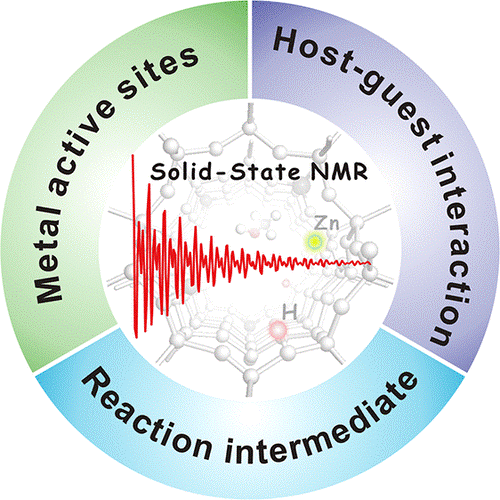Metal Active Sites and Their Catalytic Functions in Zeolites: Insights from Solid-State NMR Spectroscopy
Date:2019/7/3 16:28:43 Views:Times
Zeolites are important heterogeneous catalysts widely used in the modern chemical and petrochemical industries. Metal-containing zeolites show distinct performance in the catalytic processes such as fluid catalytic cracking, activation and conversion of light alkanes, methanol-to-aromatics conversion, biomass transformation, and so on. The metal speciation, distribution, and interactions on zeolites have enormous impact on their property and catalytic performance. Significant efforts have been devoted to the synthesis of more active and selective zeolites by engineering the metal active sites. However, the nature of metal species and their role in the reactions are still poorly understood, which makes it difficult to establish the structure–activity relationship toward the rational design and application of zeolites. For example, synergic active sites are often present on the metal-containing zeolites, but their structure, property and quantification still remain to be resolved.
Solid-state NMR is a powerful tool for the characterization of heterogeneous catalysts and catalytic reactions by providing information about both molecular structure and dynamics. The heterogeneity and low concentration of the metal sites on zeolites usually leads to a great challenge for their characterization. In this Account, we will describe our effort to study the metal active sites, host–guest interactions, and reaction intermediates by using solid-state NMR spectroscopy, with the aim to highlight recent advances in solid-state NMR techniques for probing the structure and property of metal-containing zeolites as well as the relevant reaction mechanisms.
Using sensitivity-enhanced NMR methods such as 67Zn, 71Ga, and 119Sn, NMR enables the identification of metal speciation on zeolites. The synergic active sites constituted by metal species (as Lewis acid sites) and acidic protons (as Brønsted acid sites) on zeolites that amount to only a small fraction of the whole system can be directly probed and quantified with advanced 1H–67Zn or 1H–71Ga double-resonance solid-state NMR. We developed NMR methods to study the host–guest interactions in zeolites by observing the spatial interaction/proximity between aluminum sites (associated with Brønsted or Lewis acid sites) in zeolite host and carbon atoms in organic molecule guest formed during catalytic reaction, which leads to the formation of supramolecular reaction centers in the methanol-to-olefins reaction. The mechanisms underlying the catalytic reactions on metal-modified zeolite are revealed by the identification of key reaction intermediates with in situ 13C MAS NMR spectroscopy. Our discussion based on the representative examples shows how the metal species serving as active sites significantly affect the property and activity of zeolites and related reaction pathways. The structural information obtained by the state-of-the-art solid-state NMR techniques provides new insights into the structure–activity relationship of zeolites in heterogeneous catalysis, which should be beneficial for rational design of highly efficient zeolite catalysts.

Link: https://pubs.acs.org/doi/10.1021/acs.accounts.9b00125



